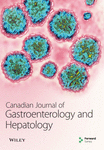Clinical Presentation and Course of Crohn′s Disease in Southeastern Ontario
Abstract
Clinical records of 222 patients with proven Crohn′s disease identified at Queen′s University Medical School in Kingston, Ontario from 1966 to 1984 were reviewed. Four clinical patterns were identified. Ileocolic disease (44%) was most trequent. Small intestinal involvement alone occurred in 30% while colonic involvement alone was documented in 18%. Gastroduodenal Crohn′s disease was diagnosed in 8.5%, but in all such patients there was involvement of additional small or large bowel. Females (57%) out-numbered males (43%) with a female to male ratio of 1.3. The age range at diagnosis was seven to 73 years and 177 patients (80%) were diagnosed between the ages of 11 and 40 years. Patients with colonic disease only tended to be older and had fewer obstructive episodes, fewer surgical resections and more gross rectal bleeding. Patients with gascroduodenal disease were more often male, usually had additional small bowel involvement, experienced more local complications and required more surgical intervention than the ocher patterns. Only one patient was identified with disease restricted to the anorectum. Patients in this series were followed from two months to 24 years. The mean duration of follow-up was 4.9 years. The frequency of complications and the necessity for surgery were similar to other reported series. None of the patients had either large or small bowel cancer during the follow-up period and there were no deaths related directly to Crohn′s disease, its complications or related surgery.




